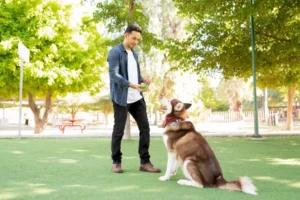Last Updated on 2 years ago by Nicky Johnson
We love our pets, but it can sometimes be hard to tell what they’re thinking. They’re wagging their tails one minute, and the next, they’re snarling at us. If we could only better understand them, we could forge even stronger bonds.
There is a lot known about how dogs communicate their feelings. You just need to learn to read the signs.
Read our guide to interpreting canine emotions through things like facial expression, posture, and eye contact to become even better BFFs.

1. Facial Expression
Blog Contents
Most dogs are loyal to their owners, even to the point of reverence. You don’t need to get your dog registered as an emotional support animal through the ESA Registration of America to feel their devotion. All you need to do is read their faces.
You may also like: Can Dogs Eat Water Chestnuts?
Dogs yawn to relieve tension and anxiety, for instance. They also lick their lips to convey anger or displeasure.
Emotions like curiosity and joy are pretty easy to read, but picking up on unique canine facial cues is essential too.
2. Posture
Dogs use their whole bodies to communicate, just like we do. A cramped posture, turned in with head down and tail between the legs doesn’t bode well for their emotional state.
But when a dog is stretched out, perked up, bounding around with ears up and eyes wide, they’re as happy as can be.
You may also like: Can Dogs Eat Oatmeal Cookies?
3. Eye Contact
If you ever visit a dog shelter or adoption center, you’ll know how powerfully dogs can convey their moods through eye contact.
Soft eyes, conveyed by relaxed lids and an easy stare, communicate love and happiness. Hard eyes, conveyed by furrowed brows and shifty eye contact, mean something is up.
When you see hard eyes, check in with your dog to see how they’re feeling.
4. Distress Signals
Most dogs are vocal creatures. They’ll tell you plainly whether they like or dislike something by barking, yapping, and yelping. They use this very often as a way to communicate with us and tell us what is up!
Generally, dogs don’t want to hurt their owners, so pay attention to vocal distress signals to avoid getting bit.
5. Tail Behavior
Dogs can feel a wide range of emotions. While they can’t communicate them in words, they’ll surely tell you with their tails. Dogs can communicate emotions like excitement, distrust, fear, and affection with their tails.
Wagging doesn’t automatically mean happiness; it just means they’re feeling something. Watch your dog’s wags and study the speed, the direction of the wag, and the connection to facial expression to learn what it communicates about their mood.
You may also like: Can Dogs Eat Beef Jerky?
Understanding Our Furry Friends
We love our furry friends, and it’s heartbreaking that we can’t talk to them like we talk to our humanoid loved ones. But we can learn to read them like we do anyone else.
Show your dog that they matter by learning to read their moods. It’s the closest thing we’ll ever get to saying, “I love you.”







